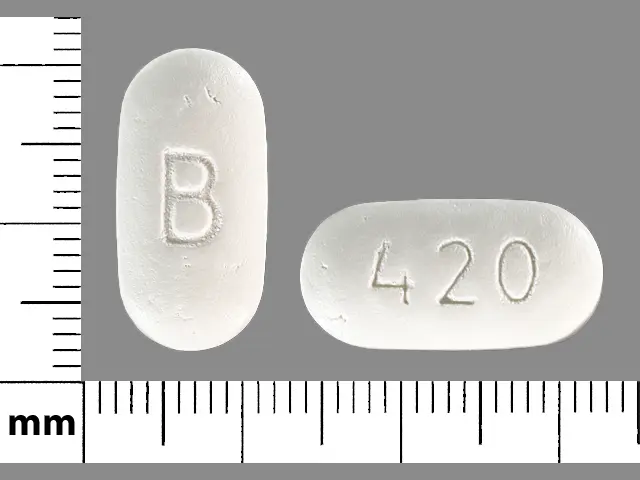Diltiazem Hydrochloride (diltiazem hydrochloride 240 mg) Dailymed
Generic: diltiazem hydrochloride extended-release tablets is used for the treatment of Angina Pectoris, Variant Atrial Fibrillation Atrial Flutter Hypertension Hypotension Myocardial Infarction Pulmonary Edema Sick Sinus Syndrome Tachycardia, Supraventricular Atrioventricular Block
IMPRINT: B 420 MG
SHAPE: oval
COLOR: white
All Imprints
diltiazem hydrochloride 300 mg - b 300 mg oval white
diltiazem hydrochloride 180 mg - b 180 mg oval white
diltiazem hydrochloride 420 mg - b 420 mg oval white
diltiazem hydrochloride 240 mg - b 240 mg oval white
Go PRO for all pill images
1 Indications And Usage
Diltiazem Hydrochloride Extended-Release Tablets is a nondihydropyridine calcium channel blocker indicated for:
‚ÄĘ treatment of hypertension, to lower blood pressure. Lowering blood pressure reduces the risk of fatal and nonfatal cardiovascular events, primarily strokes and myocardial infarctions. It can be used alone or in combination with other antihypertensives. (1.1 )‚ÄĘ improving exercise tolerance in patients with chronic stable angina. (1.2 )1.1 Hypertension
Diltiazem Hydrochloride Extended-Release Tablets are indicated for the treatment of hypertension, to lower blood pressure. Lowering blood pressure reduces the risk of fatal and nonfatal cardiovascular events, primarily strokes and myocardial infarctions. These benefits have been seen in controlled trials of antihypertensive drugs from a wide variety of pharmacologic classes including this drug.
Control of high blood pressure should be part of comprehensive cardiovascular risk management, including, as appropriate, lipid control, diabetes management, antithrombotic therapy, smoking cessation, exercise, and limited sodium intake. Many patients will require more than one drug to achieve blood pressure goals. For specific advice on goals and management, see published guidelines, such as those of the National High Blood Pressure Education Program’s Joint National Committee on Prevention, Detection, Evaluation, and Treatment of High Blood Pressure (JNC).
Numerous antihypertensive drugs, from a variety of pharmacologic classes and with different mechanisms of action, have been shown in randomized controlled trials to reduce cardiovascular morbidity and mortality, and it can be concluded that it is blood pressure reduction, and not some other pharmacologic property of the drugs, that is largely responsible for those benefits. The largest and most consistent cardiovascular outcome benefit has been a reduction in the risk of stroke, but reductions in myocardial infarction and cardiovascular mortality also have been seen regularly.
Elevated systolic or diastolic pressure causes increased cardiovascular risk, and the absolute risk increase per mm Hg is greater at higher blood pressures, so that even modest reductions of severe hypertension can provide substantial benefit. Relative risk reduction from blood pressure reduction is similar across populations with varying absolute risk, so the absolute benefit is greater in patients who are at higher risk independent of their hypertension (for example, patients with diabetes or hyperlipidemia), and such patients would be expected to benefit from more aggressive treatment to a lower blood pressure goal.
Some antihypertensive drugs have smaller blood pressure effects (as monotherapy) in black patients, and many antihypertensive drugs have additional approved indications and effects (e.g., on angina, heart failure, or diabetic kidney disease). These considerations may guide selection of therapy.
Diltiazem Hydrochloride Extended-Release Tablets may be used alone or in combination with other antihypertensive medications.
1.2 Angina
Diltiazem Hydrochloride Extended-Release Tablets are indicated to improve exercise tolerance in patients with chronic stable angina.
2 Dosage And Administration
Take Diltiazem Hydrochloride Extended-Release Tablets once a day at approximately the same time. Do not chew or crush the tablet.
‚ÄĘ Tablet should be swallowed whole and not chewed or crushed. (2 )‚ÄĘ Hypertension: Initial adult dose is 180 to 240 mg once daily. Adjust dose according to blood pressure response to a maximum of 540 mg daily. (2.1 )‚ÄĘ Angina: Initial adult dose is 180 mg once daily. Adjust dose according to response to a maximum of 360 mg. (2.2 )‚ÄĘ Switching to Diltiazem Hydrochloride Extended-Release Tablets: Patients may be switched to the nearest equivalent total daily diltiazem dose. (2.3 )2.1 Hypertension
Initiate dosing at 180 to 240 mg once daily, although some patients may respond to lower doses. Titrate according to blood pressure to a maximum of 540 mg daily. Maximum antihypertensive effect is usually observed by 14 days of chronic therapy.
2.2 Angina
Initiate dosing at 180 mg once daily and increase dose at intervals of 7 to 14 days if adequate response is not obtained, to a maximum of 360 mg.
2.3 Switching to Diltiazem Hydrochloride Extended-Release Tablets
Patients controlled on diltiazem alone or in combination with other medications may be switched to Diltiazem Hydrochloride Extended-Release Tablets once a day at the nearest equivalent total daily dose. Higher doses of Diltiazem Hydrochloride Extended-Release Tablets may be needed in some patients based on clinical response.
3 Dosage Forms And Strengths
Extended-release tablets with 120 mg, 180 mg, 240 mg, 300 mg, 360 mg, or 420 mg diltiazem hydrochloride per tablet. Diltiazem Hydrochloride Extended-Release Tablets are supplied as capsule shaped, white film-coated tablets, debossed with ‚ÄúB‚ÄĚ on one side and the diltiazem content (mg) on the other.
‚ÄĘ Extended-release tablets with 120 mg, 180 mg, 240 mg, 300 mg, 360 mg, or 420 mg diltiazem hydrochloride per tablet. (3 )
4 Contraindications
Diltiazem Hydrochloride Extended-Release Tablets are contraindicated in:
‚ÄĘ Patients with sick sinus syndrome except in the presence of a functioning ventricular pacemaker.‚ÄĘ Patients with second- or third-degree AV block except in the presence of a functioning ventricular pacemaker.‚ÄĘ Patients with hypotension (less than 90 mm Hg systolic).‚ÄĘ Patients who have demonstrated hypersensitivity to the drug.‚ÄĘ Patients with acute myocardial infarction and pulmonary.
‚ÄĘ Sick sinus syndrome except in the presence of a functioning ventricular pacemaker. (4 )‚ÄĘ Second- or third-degree AV block except in the presence of a functioning ventricular pacemaker. (4 )‚ÄĘ Hypotension (less than 90 mm Hg systolic). (4 )‚ÄĘ Hypersensitivity to the drug. (4 )‚ÄĘ Acute myocardial infarction and pulmonary. (4 )
5 Warnings And Precautions
‚ÄĘ Bradycardia, second- or third-degree AV block: Monitor heart rate and rhythm. (5.1 )‚ÄĘ Heart failure: Monitor for signs and symptoms. (5.2 )‚ÄĘ Increased liver enzymes and acute hepatic injury. (5.3 )‚ÄĘ Severe skin reactions. (5.4 )5.1 Bradycardia or AV Block
Diltiazem Hydrochloride Extended-Release Tablets may cause abnormally slow heart rates or second- or third-degree AV block. Patients with sick sinus syndrome are at increased risk of bradycardia. Concomitant use of diltiazem with beta-blockers or digitalis may result in additive effects on cardiac conduction. A patient with Prinzmetal’s angina developed periods of asystole (2 to 5 seconds) after a single dose of 60 mg of diltiazem [see Adverse Reactions (6)]. Monitor for effects on heart rate and cardiac conduction.
5.2 Heart Failure
Worsening of heart failure has been reported in patients with impairment of ventricular function. Experience with the use of diltiazem in combination with beta-blockers in patients with impaired ventricular function is limited.
5.3 Acute Hepatic Injury
Significant elevations in liver enzymes such as alkaline phosphatase, LDH, AST (SGOT), ALT (SGPT) and signs of acute hepatic injury have been reported with diltiazem therapy. These reactions tended to occur early after therapy initiation (1 to 8 weeks) and have been reversible upon discontinuation of drug therapy. Mild elevations of transaminases with and without concomitant elevation in alkaline phosphatase and bilirubin have also been observed. Such elevations were usually transient and frequently resolved even with continued diltiazem treatment.
5.4 Severe Skin Reactions
Stevens-Johnson syndrome, toxic epidermal necrolysis, erythema multiforme and/or exfoliative dermatitis have been reported.
6 Adverse Reactions
The following adverse reactions are described in greater detail, in other sections:
‚ÄĘ Bradycardia and AV block [see Warnings and Precautions (5.1)]‚ÄĘ Heart failure [see Warnings and Precautions (5.2)]‚ÄĘ Acute hepatic injury [see Warnings and Precautions (5.3)]‚ÄĘ Severe skin reactions [see Warnings and Precautions (5.4)]
The most common adverse reactions (>2%) are lower limb edema, sinus congestion and rash in patients treated for hypertension, and lower limb edema, headache, dizziness, fatigue, bradycardia, first-degree AV block and cough in patients treated for angina. (6.1 )
To report SUSPECTED ADVERSE REACTIONS, contact Oceanside Pharmaceuticals at 1-800-321-4576 or FDA at 1-800-FDA-1088 orwww.fda.gov/medwatch.
6.1 Clinical Trials Experience
Because clinical trials are conducted under widely varying conditions, adverse reaction rates observed in the clinical trials of a drug cannot be directly compared to rates in the clinical trials of another drug and may not reflect the rates observed in practice.
For the hypertension studies, the following table presents adverse reactions more common on diltiazem than on placebo (but excluding events with no plausible relationship to treatment), as reported in placebo-controlled hypertension trials in patients receiving a diltiazem hydrochloride extended-release formulation (once-a-day dosing) up to 540 mg.
Placebo Diltiazem hydrochloride extended-release Adverse Reactions (MedDRA Term) n=120 # pts. (%) 120-360 mg n=501 # pts. (%) 540 mg n=123 # pts. (%)
Edema lower limb
4 (3)
24 (5)
10 (8)
Sinus congestion
0 (0)
2 (1)
2 (2)
Rash
0 (0)
3 (1)
2 (2)
In the angina study, the adverse event profile of Diltiazem Hydrochloride Extended-Release Tablets was consistent with what has been previously described for Diltiazem Hydrochloride Extended-Release Tablets and other formulations of diltiazem HCl. The most frequent adverse effects experienced by Diltiazem Hydrochloride Extended-Release Tablets-treated patients were edema lower-limb (6.8%), dizziness (6.4%), fatigue (4.8%), bradycardia (3.6%), first-degree atrioventricular block (3.2%), and cough (2%).
In addition, the following events have been reported infrequently (less than 1%) in angina or hypertension trials:
Cardiovascular: Angina, bundle branch block, palpitations, syncope, tachycardia, ventricular extrasystoles [see Warnings and Precautions (5.1, 5.2)].
Nervous System: Abnormal dreams, amnesia, depression, gait abnormality, hallucinations, insomnia, nervousness, paresthesia, personality change, somnolence, tinnitus, tremor.
Gastrointestinal: Anorexia, constipation, diarrhea, dry mouth, dysgeusia, dyspepsia, thirst, vomiting, weight increase.
Dermatological: Petechiae, photosensitivity, pruritus, urticaria [see Warnings and Precautions (5.4)].
Other: Amblyopia, CPK increase, dyspnea, epistaxis, eye irritation, hyperglycemia, hyperuricemia, impotence, muscle cramps, nasal congestion, nocturia, osteoarticular pain, polyuria, sexual difficulties.
6.2 Post-Marketing Experience
The following adverse reactions have been identified during post-approval use of diltiazem. Because these reactions are reported voluntarily from a population of uncertain size, it is not always possible to estimate their frequency or establish a causal relationship to drug exposure.
The following post-marketing reactions have been reported infrequently in patients receiving diltiazem: acute generalized exanthematous pustulosis, allergic reactions, alopecia, angioedema (including facial or periorbital edema), erythema multiforme, extrapyramidal symptoms, gingival hyperplasia, hemolytic anemia, increased bleeding time, leukopenia, photosensitivity (including lichenoid keratosis and hyperpigmentation at sun-exposed skin areas), purpura, retinopathy, myopathy, and thrombocytopenia.
In addition, events such as myocardial infarction have been observed which are not readily distinguishable from the natural history of the disease in these patients.
A number of well-documented cases of generalized rash, some characterized as leukocytoclastic vasculitis, have been reported.
7 Drug Interactions
‚ÄĘ Beta-blockers, digitalis, and other agents known to impair cardiac contractility and conduction may increase risk for hypotension, bradycardia, and heart failure. (7.1 )‚ÄĘ CYP450 3A4: Diltiazem is both a substrate and inhibitor of CYP450 3A4. CYP450 3A4 substrates may require dosage adjustment. (7.2 )7.1 Agents Known to Impair Cardiac Contractility and Conduction
Using other agents known to affect cardiac conduction or contractility with diltiazem may increase the risk of bradycardia, AV block, and heart failure [see Warnings and Precautions (5.1, 5.2)].
Ivabradine: Concurrent use of diltiazem increases exposure to ivabradine and may exacerbate bradycardia and conduction disturbances. Avoid concomitant use of ivabradine and diltiazem.
7.2 Interactions with Cytochrome P450 3A4 Substrates, Inhibitors and Inducers
Diltiazem is both a substrate and an inhibitor of the cytochrome P450 3A4 enzyme system.
Simvastatin: Limit daily dose of simvastatin to 10 mg and diltiazem to 240 mg, if coadministration of both drugs is required [see Clinical Pharmacology (12.3)].
Rifampin: Avoid coadministration of rifampin with diltiazem [see Clinical Pharmacology (12.3)].
8 Use In Specific Populations
8.1 Pregnancy
Pregnancy Category C. Reproduction studies have been conducted in mice, rats, and rabbits. Administration of doses ranging from five to ten times (on a mg/kg basis) the daily recommended therapeutic dose has resulted in embryo and fetal lethality. These doses, in some studies, have been reported to cause skeletal abnormalities. In the perinatal/postnatal studies, there was an increased incidence of stillbirths at doses of 20 times the human dose or greater.
There are no well-controlled studies in pregnant women; therefore, use diltiazem in pregnant women only if the potential benefit justifies the risk to the fetus.
8.3 Nursing Mothers
Diltiazem is excreted in human milk. One report suggests that concentrations in breast milk may approximate serum levels. Because of the potential for serious adverse reactions in nursing infants from diltiazem, a decision should be made whether to discontinue nursing or to discontinue the drug, taking into account the importance of the drug to the mother.
8.4 Pediatric Use
Safety and effectiveness in pediatric patients have not been established.
8.5 Geriatric Use
Clinical studies of diltiazem did not include sufficient numbers of subjects aged 65 and over to determine whether they respond differently from younger subjects. Other reported clinical experience has not identified differences in responses between the elderly and younger patients. In general, dose selection for an elderly patient should be cautious, usually starting at the low end of the dosing range, reflecting the greater frequency of decreased hepatic, renal, or cardiac function, and of concomitant disease or other drug therapy.
8.6 Use in Renal Impairment
No dose adjustment is necessary.
8.7 Use in Hepatic Impairment
No dose adjustment is likely to be needed for mild-moderate hepatic impairment.
10 Overdosage
The oral LD50 is 415 to 740 mg/kg in mice and 560 to 810 mg/kg in rats. The intravenous LD50 is 60 mg/kg in mice and 38 mg/kg in rats. The oral LD50 in dogs is considered to be in excess of 50 mg/kg, while lethality was seen in monkeys at 360 mg/kg.
The toxic dose in man is not known. Blood levels after a standard dose of diltiazem can vary over tenfold, limiting the usefulness of blood levels in overdose cases.
There have been 29 reports of diltiazem overdose in doses ranging from less than 1 g to 18 g. Sixteen of these reports involved multiple drug ingestions.
Twenty-two reports indicated patients had recovered from diltiazem overdose ranging from less than 1 g to 10.8 g. There were seven reports with a fatal outcome; although the amount of diltiazem ingested was unknown, multiple drug ingestions were confirmed in six of the seven reports.
Events observed following diltiazem overdose included bradycardia, hypotension, heart block, and cardiac failure. Most reports of overdose described some supportive medical measure and/or drug treatment. Bradycardia frequently responded favorably to atropine as did heart block, although cardiac pacing was also frequently utilized to treat heart block. Fluids and vasopressors were used to maintain blood pressure and in cases of cardiac failure, inotropic agents were administered. In addition, some patients received treatment with ventilatory support, gastric lavage, activated charcoal, and/or intravenous calcium.
In the event of overdose or exaggerated response, institute appropriate supportive measures and gastrointestinal decontamination. Diltiazem does not appear to be removed by peritoneal or hemodialysis. Limited data suggest that plasmapheresis or charcoal hemoperfusion may hasten diltiazem elimination following overdose. Based on the known pharmacological effects of diltiazem and/or reported clinical experiences, the following measures may be considered:
Bradycardia: Administer atropine (0.60 to 1.0 mg). If there is no response to vagal blockage, administer isoproterenol cautiously.
High-degree AV Block: Treat as for bradycardia above. Fixed high-degree AV block should be treated with cardiac pacing.
Cardiac Failure: Administer inotropic agents (isoproterenol, dopamine, or dobutamine) and diuretics.
Hypotension: Use vasopressors (e.g., dopamine or norepinephrine).
Actual treatment and dosage should depend on the severity of the clinical situation and the judgment and experience of the treating physician.
11 Description
Diltiazem hydrochloride is a nondihydropyridine calcium channel blocker (slow channel blocker or calcium antagonist). Chemically, diltiazem hydrochloride is 1,5-benzothiazepin-4(5H)-one, 3-(acetyloxy)-5-[2-(dimethylamino)ethyl]-2, 3-dihydro-2-(4-methoxyphenyl)-, monohydrochloride, (+)-cis-. The structural formula is:

Diltiazem hydrochloride is a white to off-white crystalline powder with a bitter taste. It is soluble in water, methanol and chloroform. It has a molecular weight of 450.99. Diltiazem Hydrochloride Extended-Release Tablets are formulated as a once-a-day extended-release tablet for oral administration containing 120 mg, 180 mg, 240 mg, 300 mg, 360 mg or 420 mg of diltiazem hydrochloride.
Tablets also contain: carnauba wax, colloidal silicon dioxide, croscarmellose sodium, ethyl acrylate and methyl methacrylate copolymer dispersion, hydrogenated vegetable oil, hypromellose, magnesium stearate, microcrystalline cellulose, microcrystalline wax, polydextrose, polyethylene glycol, polysorbate, povidone, pregelatinized starch, simethicone, sodium starch glycolate, sucrose stearate, talc, and titanium dioxide.
12 Clinical Pharmacology
12.1 Mechanism of Action
The therapeutic effects of diltiazem are believed to be related to its ability to inhibit the cellular influx of calcium ions during membrane depolarization of cardiac and vascular smooth muscle.
Hypertension: Diltiazem produces its antihypertensive effect primarily by relaxation of vascular smooth muscle and the resultant decrease in peripheral vascular resistance. The magnitude of blood pressure reduction is related to the degree of hypertension; thus hypertensive individuals experience an antihypertensive effect, whereas there is only a modest fall in blood pressure in normotensives.
Angina: Diltiazem has been shown to produce increases in exercise tolerance, probably due to its ability to reduce myocardial oxygen demand. This is accomplished via reductions in heart rate and systemic blood pressure at submaximal and maximal workloads. Diltiazem has been shown to be a potent dilator of coronary arteries, both epicardial and subendocardial. Spontaneous and ergonovine-induced coronary artery spasms are inhibited by diltiazem.
In animal models, diltiazem interferes with the slow inward (depolarizing) current in excitable tissue. Diltiazem causes excitation-contraction uncoupling in various myocardial. Diltiazem produces relaxation of coronary vascular smooth muscle and dilation of both large and small coronary arteries at drug levels which cause little or no negative inotropic effect. The resultant increases in coronary blood flow (epicardial and subendocardial) occur in ischemic and nonischemic models and are accompanied by dose-dependent decreases in systemic blood pressure and decreases in peripheral resistance.
12.2 Pharmacodynamics
Like other calcium channel antagonists, diltiazem decreases sinoatrial and atrioventricular conduction in isolated tissues and has a negative inotropic effect in isolated preparations. In the intact animal, prolongation of the AH interval can be seen at higher doses.
In man, diltiazem prevents spontaneous and ergonovine-provoked coronary artery spasm. It causes a decrease in peripheral vascular resistance and a modest fall in blood pressure in normotensive individuals and, in exercise tolerance studies in patients with ischemic heart disease, reduces the heart rate-blood pressure product for any given workload. Studies to date, primarily in patients with good ventricular function, have not revealed evidence of a negative inotropic effect; cardiac output, ejection fraction, and left ventricular end diastolic pressure have not been affected. Such data have no predictive value with respect to effects in patients with poor ventricular function, and increased heart failure has been reported in patients with preexisting impairment of ventricular function. There are as yet few data on the interaction of diltiazem and beta-blockers in patients with poor ventricular function. Resting heart rate is usually slightly reduced by diltiazem. Diltiazem decreases vascular resistance, increases cardiac output (by increasing stroke volume), and produces a slight decrease or no change in heart rate.
During dynamic exercise, increases in diastolic pressure are inhibited, while maximum achievable systolic pressure is usually reduced. Chronic therapy with diltiazem produces no change or an increase in plasma catecholamines. No increased activity of the renin-angiotensin-aldosterone axis has been observed. Diltiazem reduces the renal and peripheral effects of angiotensin II. Hypertensive animal models respond to diltiazem with reductions in blood pressure and increased urinary output and natriuresis without a change in urinary sodium/potassium ratio.
Intravenous diltiazem hydrochloride 20 mg prolongs AH conduction time and AV node functional and effective refractory periods by approximately 20%. In a study involving single oral doses of diltiazem hydrochloride 300 mg in six normal volunteers, the average maximum PR prolongation was 14% with no instances of greater than first-degree AV block. Diltiazem associated prolongation of the AH interval is not more pronounced in patients with first-degree heart block. In patients with sick sinus syndrome, diltiazem significantly prolongs sinus cycle length (up to 50% in some cases).
Chronic oral administration of diltiazem hydrochloride to patients in doses of up to 540 mg/day has resulted in small increases in PR interval, and on occasion produces abnormal prolongation [see Warnings and Precautions (5.1)].
12.3 Pharmacokinetics
Diltiazem is well absorbed from the gastrointestinal tract and is subject to an extensive first-pass effect, giving an absolute bioavailability (compared to intravenous administration) of about 40%. Diltiazem undergoes extensive metabolism in which only 2% to 4% of the unchanged drug appears in the urine. Drugs that induce or inhibit hepatic microsomal enzymes may alter diltiazem disposition.
Total radioactivity measurement following short IV administration in healthy volunteers suggests the presence of other unidentified metabolites, which attain higher concentrations than those of diltiazem and are more slowly eliminated; half-life of total radioactivity is about 20 hours compared to 2 to 5 hours for diltiazem.
In vitrobinding studies show diltiazem is 70% to 80% bound to plasma proteins. Competitive in vitroligand binding studies have also shown diltiazem hydrochloride binding is not altered by therapeutic concentrations of digoxin, hydrochlorothiazide, phenylbutazone, propranolol, salicylic acid, or warfarin. The plasma elimination half-life following single or multiple drug administration is approximately 3.0 to 4.5 hours. Desacetyl diltiazem is also present in the plasma at levels of 10% to 20% of the parent drug and is 25% to 50% as potent as a coronary vasodilator as diltiazem. Minimum therapeutic plasma diltiazem concentrations appear to be in the range of 50 to 200 ng/mL. There is a departure from linearity when dose strengths are increased; the half-life is slightly increased with dose.
A study that compared patients with normal hepatic function to patients with cirrhosis found an increase in half-life and a 69% increase in bioavailability in the hepatically impaired patients. A single study in nine patients with severely impaired renal function showed no difference in the pharmacokinetic profile of diltiazem compared to patients with normal renal function.
Diltiazem Hydrochloride Extended-Release Tablets: A single 360 mg dose of Diltiazem Hydrochloride Extended-Release Tablets results in detectable plasma levels within 3 to 4 hours and peak plasma levels between 11 and 18 hours; absorption occurs throughout the dosing interval. The apparent elimination half-life for Diltiazem Hydrochloride Extended-Release Tablets after single or multiple dosing is 6 to 9 hours. When Diltiazem Hydrochloride Extended-Release Tablets were coadministered with a high fat content breakfast, diltiazem peak and systemic exposures were not affected indicating that the tablet can be administered without regard to food. As the dose of Diltiazem Hydrochloride Extended-Release Tablets is increased from 120 to 240 mg, area-under-the-curve (AUC) increases 2.5-fold.
Drug Interactions
Impact of Diltiazem on Other Coadministered Drugs
Anesthetics: The depression of cardiac contractility, conductivity, and automaticity as well as the vascular dilation associated with anesthetics may be potentiated by calcium channel blockers. When used concomitantly, anesthetics and calcium blockers should be titrated carefully.
Benzodiazepines: Studies showed that diltiazem increased the AUC of midazolam and triazolam by 3- to 4-fold and the Cmax by 2-fold, compared to placebo. The elimination half-life of midazolam and triazolam also increased (1.5- to 2.5-fold) during coadministration with diltiazem. These pharmacokinetic effects seen during diltiazem coadministration can result in increased clinical effects (e.g., prolonged sedation) of both midazolam and triazolam.
Beta-blockers: Controlled and uncontrolled domestic studies suggest that concomitant use of diltiazem and beta-blockers is usually well tolerated, but available data are not sufficient to predict the effects of concomitant treatment in patients with left ventricular dysfunction or cardiac conduction abnormalities.
Administration of diltiazem concomitantly with propranolol in five normal volunteers resulted in increased propranolol levels in all subjects and bioavailability of propranolol was increased approximately 50%. In vitro, propranolol appears to be displaced from its binding sites by diltiazem. If combination therapy is initiated or withdrawn in conjunction with propranolol, an adjustment in the propranolol dose may be warranted [see Warnings and Precautions (5.1, 5.2)].
Buspirone: In nine healthy subjects, diltiazem significantly increased the mean buspirone AUC 5.5-fold and Cmax 4.1-fold compared to placebo. The elimination half-life and Tmax of buspirone were not significantly affected by diltiazem. Enhanced effects and increased toxicity of buspirone may be possible during concomitant administration with diltiazem. Subsequent dose adjustments may be necessary during coadministration,and should be based on clinical assessment.
Carbamazepine: Concomitant administration of diltiazem with carbamazepine has been reported to result in elevated serum levels of carbamazepine (40% to 72% increase), resulting in toxicity in some cases.
Clonidine: Sinus bradycardia resulting in hospitalization and pacemaker insertion has been reported in association with the use of clonidine concurrently with diltiazem. Monitor heart rate in patients receiving concomitant diltiazem and clonidine.
Cyclosporine: A pharmacokinetic interaction between diltiazem and cyclosporine has been observed during studies involving renal and cardiac transplant patients. In renal and cardiac transplant recipients, a reduction of cyclosporine dose ranging from 15% to 48% was necessary to maintain cyclosporine trough concentrations similar to those seen prior to the addition of diltiazem. If these agents are to be administered concurrently, cyclosporine concentrations should be monitored, especially when diltiazem therapy is initiated, adjusted, or discontinued. The effect of cyclosporine on diltiazem plasma concentrations has not been evaluated.
Digitalis: Administration of diltiazem with digoxin in 24 healthy male subjects increased plasma digoxin concentrations approximately 20%. Another investigator found no increase in digoxin levels in 12 patients with coronary artery disease. Monitor digoxin levels when initiating, adjusting, and discontinuing diltiazem therapy to avoid possible over- or under-digitalization [see Warnings and Precautions (5.1)].
Quinidine: Diltiazem increases the AUC (0‚Üí‚ąě) of quinidine by 51%, elimination half-life by 36%, and decreases its oral clearance by 33%. Monitor for quinidine adverse effects and adjust the dose adjusted.
Statins: Diltiazem has been shown to increase significantly the AUC of some statins. The risk of myopathy and rhabdomyolysis with statins metabolized by CYP3A4 may be increased with concomitant use of diltiazem. When possible, use a non-CYP3A4-metabolized statin together with diltiazem; otherwise, dose adjustments for both diltiazem and the statin should be considered along with close monitoring for signs and symptoms of any statin-related adverse events.
In a healthy volunteer cross-over study (N=10), coadministration of a single 20 mg dose of simvastatin at the end of a 14-day regimen with 120 mg BID diltiazem SR resulted in a 5-fold increase in mean simvastatin AUC versus simvastatin alone. Subjects with increased average steady-state exposures of diltiazem showed a greater fold increase in simvastatin exposure. Computer-based simulations showed that at a daily dose of 480 mg of diltiazem, an 8- to 9-fold mean increase in simvastatin AUC can be expected. If coadministration of simvastatin with diltiazem is required, limit the daily doses of simvastatin to 10 mg and diltiazem to 240 mg.
In a ten-subject randomized, open label, 4-way cross-over study, coadministration of diltiazem (120 mg BID diltiazem SR for 2 weeks) with a single 20 mg dose of lovastatin resulted in 3- to 4-fold increase in mean lovastatin AUC and Cmax versus lovastatin alone. In the same study, there was no significant change in 20 mg single dose pravastatin AUC and Cmax during diltiazem coadministration. Diltiazem plasma levels were not significantly affected by lovastatin or pravastatin.
Impact of Other Coadministered Drugs on Diltiazem Include, but Not Limited to:
Rifampin: Coadministration of rifampin with diltiazem lowered the diltiazem plasma concentrations to undetectable levels. Coadministration of diltiazem with rifampin or any known CYP3A4 inducer should be avoided when possible, and alternative therapy considered.
Cimetidine and Ranitidine: A study in six healthy volunteers has shown a significant increase in peak diltiazem plasma levels (58%) and AUC (53%) after a 1-week course of cimetidine at 1200 mg per day and a single dose of diltiazem 60 mg. Ranitidine produced smaller, non-significant increases. The effect may be mediated by cimetidine’s known inhibition of hepatic cytochrome P450, the enzyme system responsible for the first-pass metabolism of diltiazem. Patients currently receiving diltiazem therapy should be carefully monitored for a change in pharmacological effect when initiating and discontinuing therapy with cimetidine. An adjustment in the diltiazem dose may be warranted.
13 Nonclinical Toxicology
13.1 Carcinogenesis, Mutagenesis, Impairment of Fertility
A 24-month study in rats at oral dosage levels of up to 100 mg/kg/day, and a 21-month study in mice at oral dosage levels of up to 30 mg/kg/day showed no evidence of carcinogenicity. There was also no mutagenic response in vitro or in vivo in mammalian cell assays or in vitro in bacteria. No evidence of impaired fertility was observed in a study performed in male and female rats at oral dosages of up to 100 mg/kg/day.
14 Clinical Studies
14.1 Hypertension
In a randomized, double-blind, parallel-group, dose-response study involving 478 patients with essential hypertension, evening doses of Diltiazem Hydrochloride Extended-Release Tablets 120, 240, 360, and 540 mg were compared to placebo and to 360 mg administered in the morning. The mean reductions in diastolic blood pressure by ABPM at roughly 24 hours after the morning (4 AM to 8 AM) or evening (6 PM to 10 PM) administration (i.e., the time corresponding to expected trough serum concentrations) are shown in the table below:
Mean Change in Trough Diastolic Pressure by ABPM
Evening Dosing
Morning Dosing
120 mg
240 mg
360 mg
540 mg
360 mg
-2.0
-4.4
-4.4
-8.1
  -6.4
A second randomized, double-blind, parallel-group, dose-response study (N=258) evaluated Diltiazem Hydrochloride Extended-Release Tablets following morning doses of placebo or 120, 180, 300, or 540 mg. Diastolic blood pressure measured by supine office cuff sphygmomanometer at trough (7 AM to 9 AM) decreased in an apparently linear manner over the dosage range studied. Group mean changes for placebo, 120 mg, 180 mg, 300 mg and 540 mg were -2.6, -1.9, -5.4, -6.1, and -8.6 mm Hg, respectively.
Whether the time of administration impacts the clinical benefits of antihypertensive treatment is not known.
Postural hypotension is infrequently noted upon suddenly assuming an upright position. No reflex tachycardia is associated with the chronic antihypertensive effects.
14.2 Angina
The effects of Diltiazem Hydrochloride Extended-Release Tablets on angina were evaluated in a randomized, double-blind, parallel-group, dose-response trial of 311 patients with chronic stable angina. Evening doses of 180, 360, and 420 mg were compared to placebo and to 360 mg administered in the morning. All doses of Diltiazem Hydrochloride Extended-Release Tablets administered at night increased exercise tolerance when compared with placebo after 21 hours. The mean effect, placebo-subtracted, was 20 to 28 seconds for all three doses, and no dose-response was demonstrated. Diltiazem Hydrochloride Extended-Release Tablets, 360 mg, given in the morning, also improved exercise tolerance when measured 25 hours later. As expected, the effect was smaller than the effects measured only 21 hours following nighttime administration. Diltiazem Hydrochloride Extended-Release Tablets had a larger effect to increase exercise tolerance at peak serum concentrations than at trough.
16 How Supplied/storage And Handling
Diltiazem Hydrochloride Extended-Release Tablets are supplied as capsule shaped, white, film-coated tablets, debossed with ‚ÄúB‚ÄĚ on one side and the diltiazem content (mg) on the other.
Strength NDC # Bottles of 30 NDC # Bottles of 90
120 mg
NDC 68682-704-30
NDC 68682-704-90
180 mg
NDC 68682-705-30
NDC 68682-705-90
240 mg
NDC 68682-706-30
NDC 68682-706-90
300 mg
NDC 68682-707-30
NDC 68682-707-90
360 mg
NDC 68682-708-30
NDC 68682-708-90
420 mg
NDC 68682-709-30
NDC 68682-709-90
STORAGE AND HANDLING SECTION
Storage conditions: Store at 25¬įC (77¬įF); excursions permitted to 15¬į to 30¬įC (59¬į to 86¬įF) [see USP Controlled Room Temperature].
Avoid excessive humidity and temperatures above 30¬įC (86¬įF).
Dispense in tight, light resistant container as defined in USP.
17 Patient Counseling Information
Advise patients:
¬† ‚ÄĘ That the Diltiazem Hydrochloride Extended-Release Tablets should be swallowed whole and not chewed or crushed.‚ÄĘ To consult the physician who prescribed Diltiazem Hydrochloride Extended-Release Tablets before taking or¬† stopping any other medications, including over-the-counter products or nutritional supplements, such as St. John‚Äôs¬† wort.‚ÄĘ To contact the physician who prescribed Diltiazem Hydrochloride Extended-Release Tablets or any other physician¬† immediately if they experience possible adverse reactions, including bradycardia, arrhythmias, symptoms indicative¬† of hypotension or heart failure, hepatic and skin reactions.‚ÄĘ To consult their physician if they become pregnant while taking Diltiazem Hydrochloride Extended-Release¬† Tablets or plan to become pregnant.
Distributed by: Oceanside Pharmaceuticals, a division of Bausch Health US, LLCBridgewater, NJ 08807 USA Manufactured by: Bausch Health Companies Inc.Steinbach, MB R5G 1Z7, Canada
© 2019 Bausch Health Companies Inc. or its affiliates
9474102 20002647
Principal Display Panel 120 Mg Bottle Label
NDC 68682-704-90
Rx only DILTIAZEMHYDROCHLORIDEEXTENDED-RELEASETABLETS
120 mg
90 Tablets
OCEANSIDE PHARMACEUTICALS
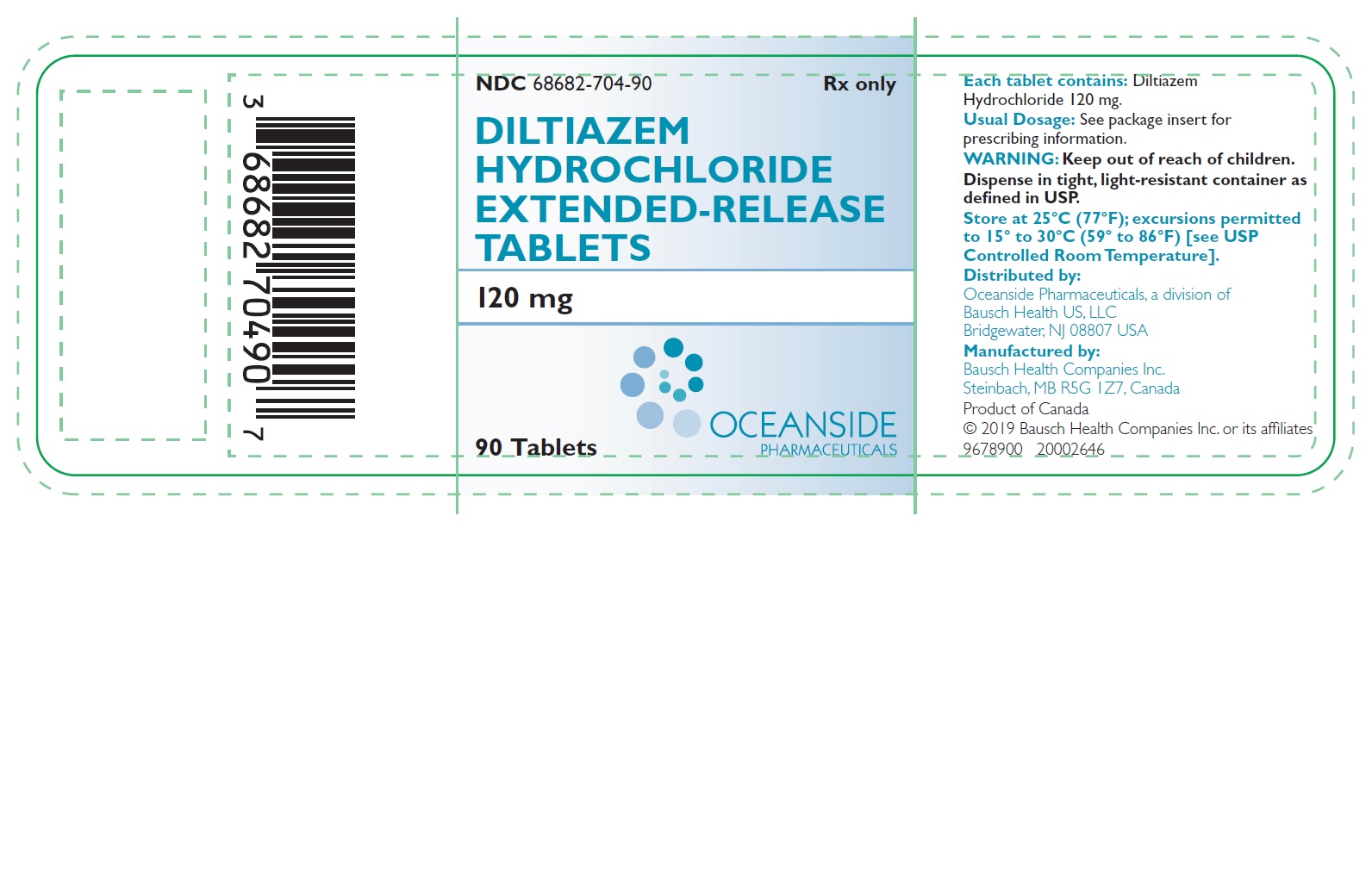
Principal Display Panel - 180 Mg Bottle Label
NDC 68682-705-90 Rx only DILTIAZEMHYDROCHLORIDEEXTENDED-RELEASETABLETS
180 mg
90 Tablets
OCEANSIDE PHARMACEUTICALS
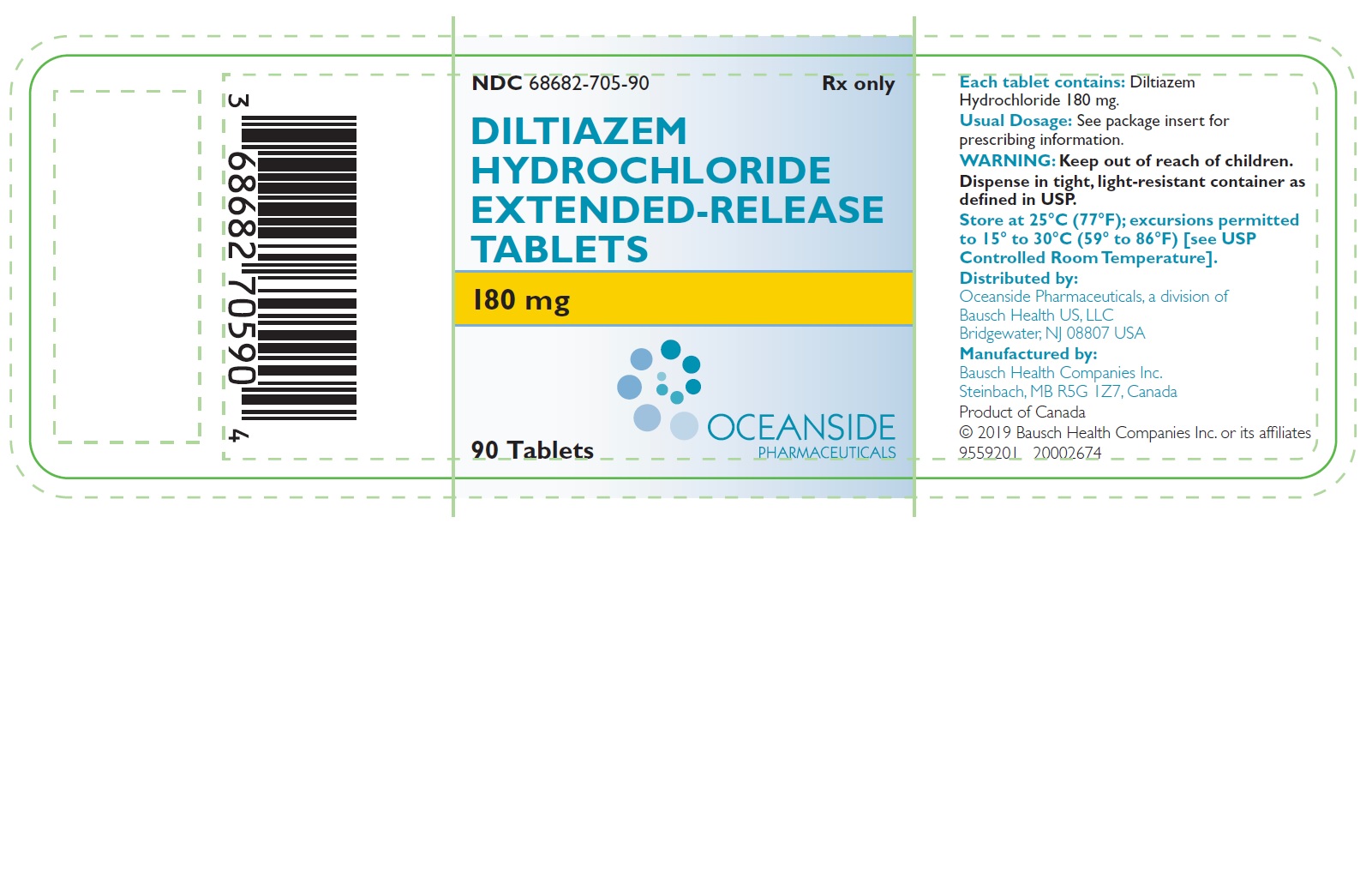
Principal Display Panel - 240 Mg Bottle Label
NDC 68682-706-90
Rx Only
DILTIAZEMHYDROCHLORIDEEXTENDED-RELEASETABLETS 240 mg
90 Tablets OCEANSIDE PHARMACEUTICALS
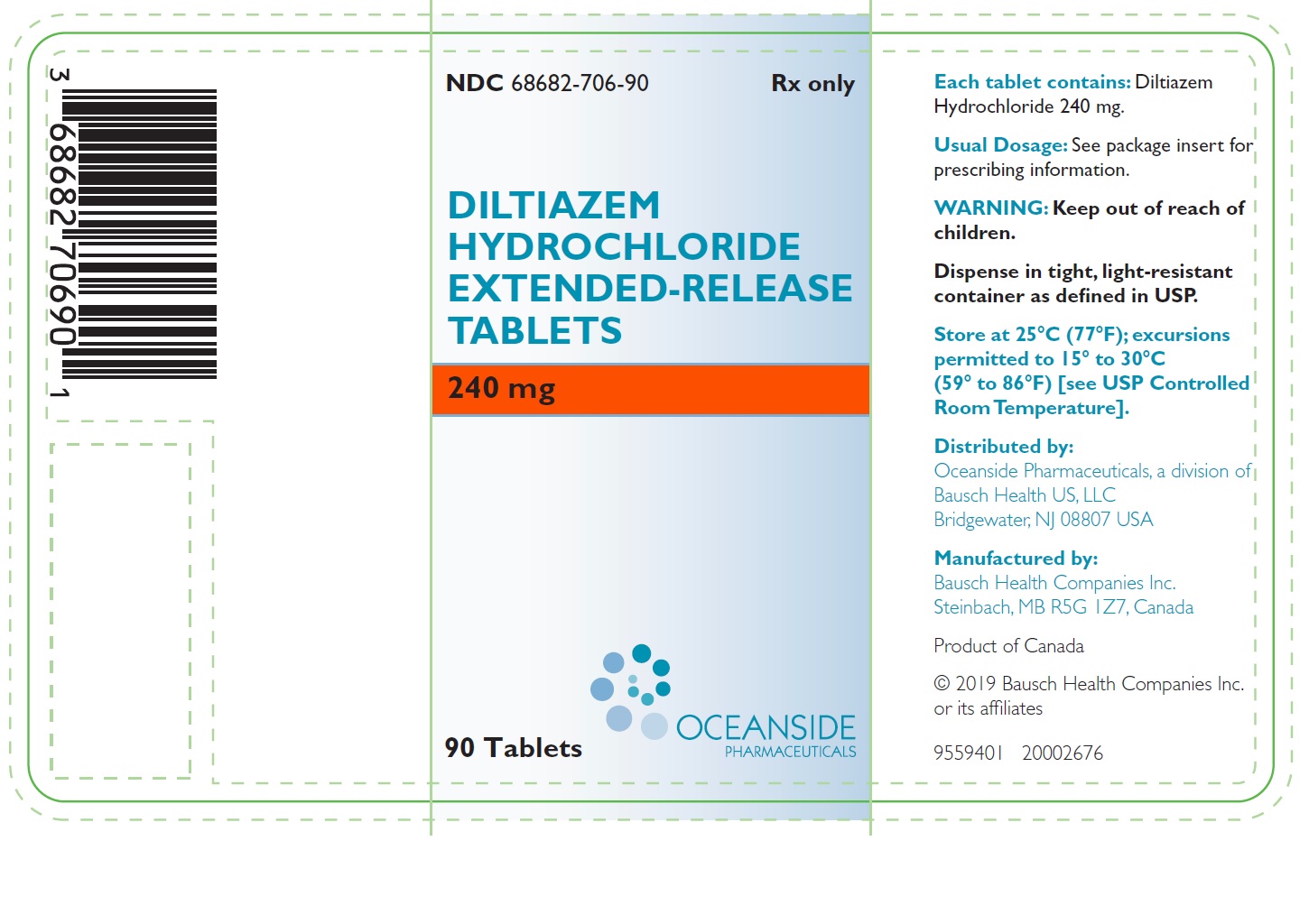
Principal Display Panel - 300 Mg Bottle Label
NDC 68682-707-90
Rx Only
DILTIAZEMHYDROCHLORIDEEXTENDED-RELEASETABLETS 300 mg
90 Tablets
OCEANSIDE PHARMACEUTICALS
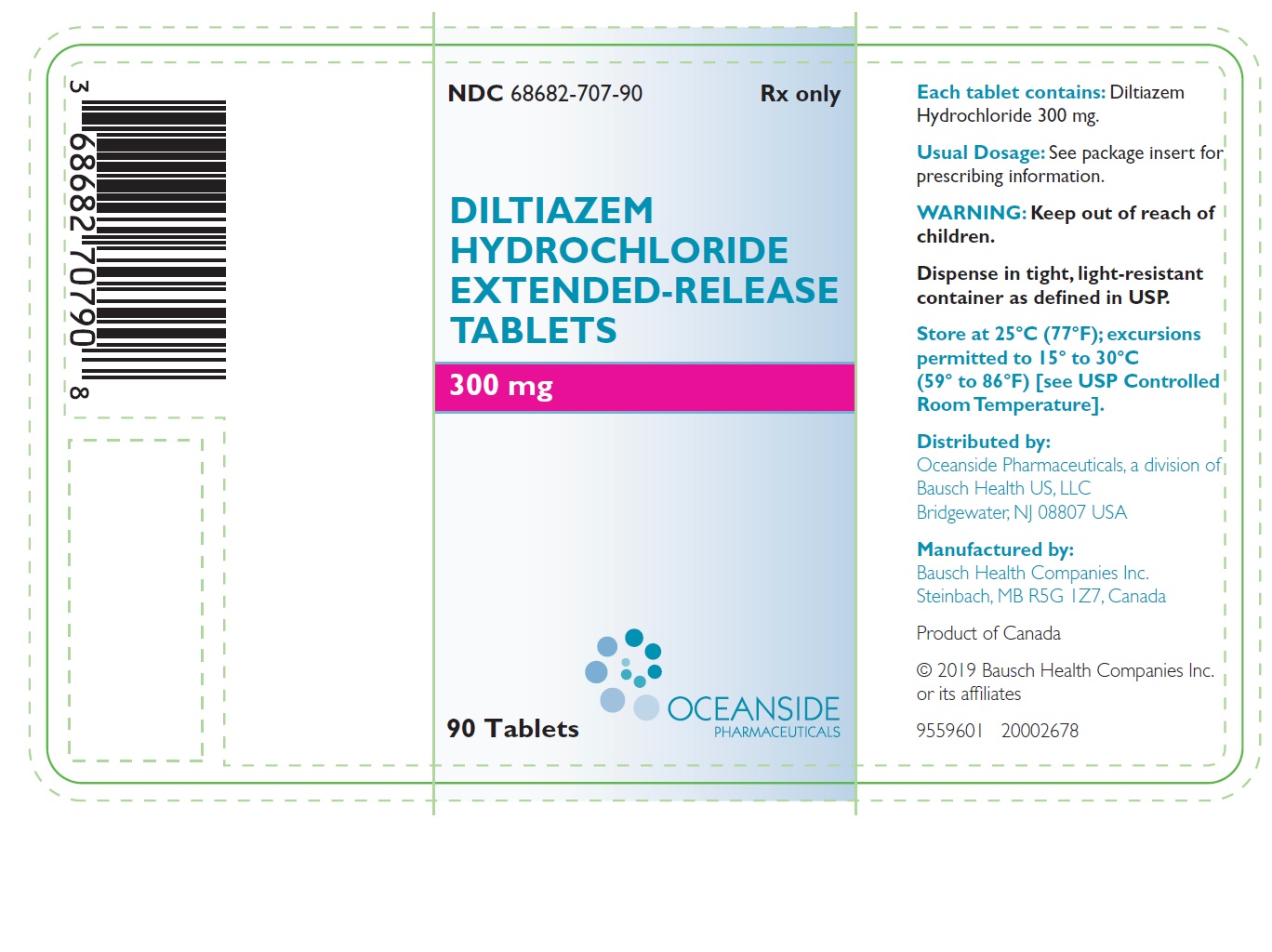
Principal Display Panel - 360 Mg Bottle Label
NDC 68682-708-90
Rx Only
DILTIAZEMHYDROCHLORIDEEXTENDED-RELEASETABLETS 360 mg
90 Tablets
OCEANSIDE PHARMACEUTICALS
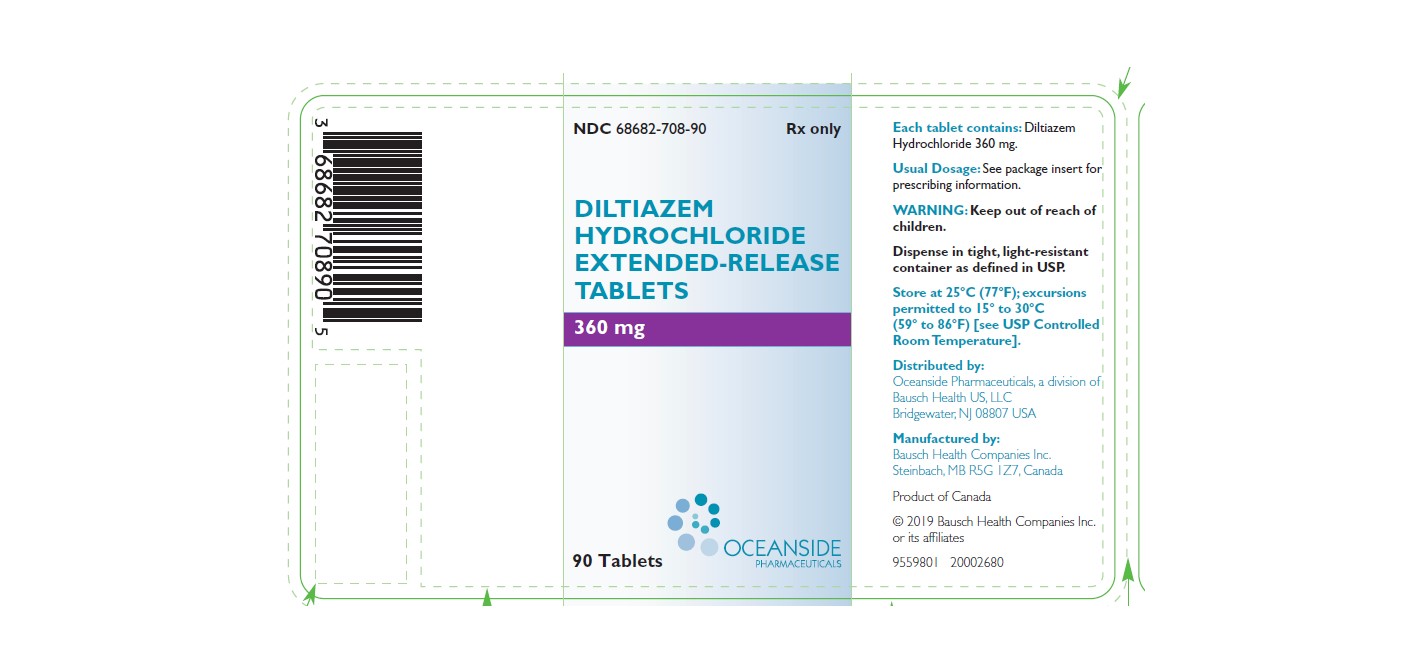
Principal Display Panel - 420 Mg Bottle Label
NDC 68682-709-90
Rx Only
DILTIAZEMHYDROCHLORIDEEXTENDED-RELEASETABLETS 420 mg
90 Tablets OCEANSIDE PHARMACEUTICALS
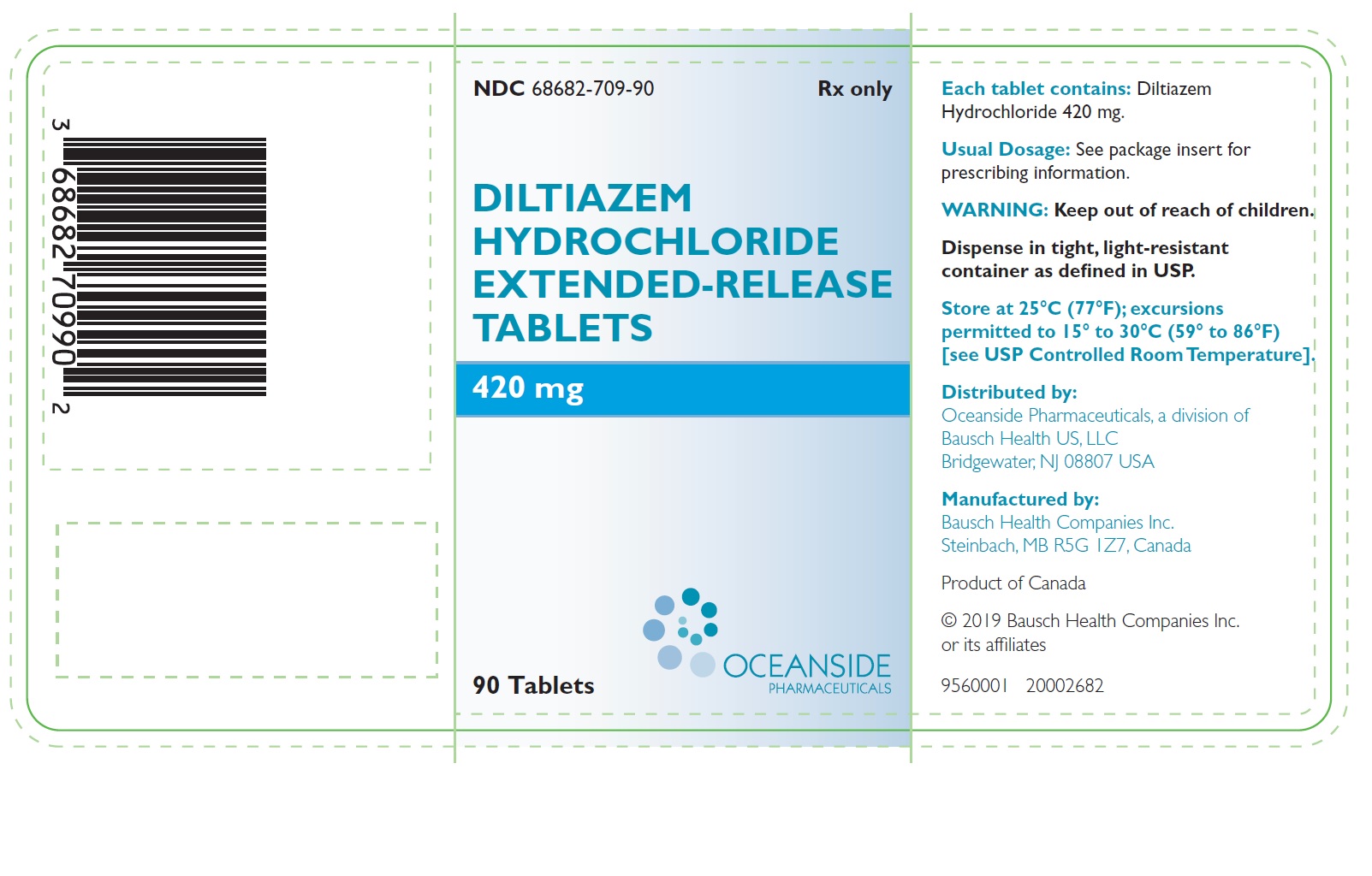
DISCLAIMER:
"This tool does not provide medical advice, and is for informational and educational purposes only, and is not a substitute for professional medical advice, treatment or diagnosis. Call your doctor to receive medical advice. If you think you may have a medical emergency, please dial 911."
"Do not rely on openFDA to make decisions regarding medical care. While we make every effort to ensure that data is accurate, you should assume all results are unvalidated. We may limit or otherwise restrict your access to the API in line with our Terms of Service."
"This product uses publicly available data from the U.S. National Library of Medicine (NLM), National Institutes of Health, Department of Health and Human Services; NLM is not responsible for the product and does not endorse or recommend this or any other product."
PillSync may earn a commission via links on our site
